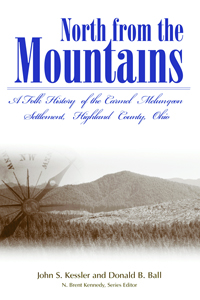Review of Kessler, John S.; Ball, Donald B., North From the Mountains: A Folk History of the Carmel Melungeon Settlement, Highland County, Ohio
H-Net Reviews
June 2002
Penny Messinger, Assistant Professor of History
Daemen College, Amherst, New York
John S. Kessler, Donald B. Ball. North From the Mountains: A Folk History of the Carmel Melungeon Settlement, Highland County, Ohio. Macon, Ga.: Mercer University Press, 2001. xiii + 220 pp., ISBN 978-0-86554-703-2; ISBN 978-0-86554-700-1.
Ethnic Diversity in Appalachia and Appalachian Ohio
Scholars of the Appalachian South have begun to explore the ethnic and racial diversity of the region as part of an attempt to go beyond the one-dimensional stereotype of the white, “one hundred percent American” hillbilly that has frequently prevailed in depictions of the area’s residents. Kessler and Ball offer an interesting contribution to this effort. The title, North from the Mountains, while specifically describing migration from the mountains of eastern Kentucky to the hills of southern Ohio, also refers to a migration from South to North that took place in several steps, over several generations. The group that established the settlement in the small crossroads community of Carmel, Ohio had its origins, the authors explain, in a multi-racial community that formed in the mid-Atlantic colonies between the mid-1600s and 1800. Members of the group relocated to the disputed borderlands of the Virginia and North Carolina mountains during the 1790s, where they were called “Melungeons,” and from there to Magoffin County (then part of Floyd County), Kentucky, by 1810. Migrants from Magoffin County settled in Highland County, Ohio, around 1864, forming the Carmel Melungeon settlement. The Melungeon settlement straddled the borders of Highland and Pike counties and spread south and east from Carmel, a small crossroads community not far from the current Fort Hill State Memorial. Although it never grew into a town, during the 1940s Carmel was large enough to sustain a store, schools (later absorbed during the consolidation process), two churches, and several cemeteries. At its peak size around 1900, Carmel had included additional stores and businesses, an attorney, and a post office (operating from 1856 until 1921). The Melungeon settlement in Carmel appears to have reached its peak size of around 150 people during the 1940s.
The questions “Who are the Melungeons?” and “Where did they come from?” have intrigued anthropologists, novelists, and regional scholars for many decades. To an even greater degree than is the case for other residents of the Southern Appalachians, the group has been the subject of stereotype and myth. The term “Melungeon” is explained as an adaptation of the French “mélange,” meaning “mixture,” and has sometimes been used as an epithet. Kessler and Ball use the Spanish “mestizo,” meaning a person of mixed racial ancestry, to characterize members of the Melungeon communities. The term “Melungeon” describes several insular, multi-ethnic, or multi-racial communities within the Appalachian region, notably those located in Hancock and Hawkins counties in Tennessee, and Lee, Scott, and Wise counties in Virginia. However, Kessler and Ball argue that this definition should be expanded to include “genetically comparable and similarly named families throughout an area covering at least twenty-nine adjacent counties variously located in northwestern North Carolina, southwestern Virginia, northeastern Tennessee, and southeastern Kentucky,” in addition to the Carmel settlement (p. 2). These mixed-race communities were often held in low regard by their neighbors, creating a sense of shared identity among residents within the community that was reinforced by hostility from outside. Historically, the attitude of residents of the communities surrounding mestizo settlements was often manifested in a refusal to intermarry with the community members, a pattern that served to reinforce group identity and to preserve racial composition. Kessler and Ball also provide concise discussions of other mestizo populations within the Appalachian area that are unrelated to the Melungeon groups and delineate the points of distinction among the groups.
During the 1940s and 1950s, anthropologists described Melungeon communities as “tri-racial isolates,” a term that emphasized a mixed heritage of white, African, and Native American ancestry. The authors note that group members generally emphasized their Native American rather than their African ancestry, although both races contributed to the group’s ethnic mix. A more controversial aspect of Melungeon identity is the group’s claim of Portuguese and/or Middle Eastern ancestry. Molecular biologist Kevin Jones is currently coordinating a project to analyze genetic material from Melungeon community members in order to answer the question of ancestry. N. Brent Kennedy, who edits the series “The Melungeons,” addresses the issue of identity in the book’s foreword. Kennedy is also the author of a recent book on the Melungeons and a leader in the movement for Melungeon pride and identity.[1] In discussing the ancestry of the group, Kennedy writes, “No doubt some of us are primarily Native American; others more Turkish and/or central Asian; still others more Portuguese, or Semitic, or African. But, despite the old argument that the Melungeon claim to be of various origins is ‘proof’ against all origins, there is no conflict in such a multiplicity of claims. We were more multicultural than the average Englishman when we first arrived. And, like all Americans, we Melungeons have also become even more multicultural and multiethnic with the passage of time.” Kennedy continues, “Early America was far more ethnically and racially complex than we have been taught. Some whites were not northern European, some blacks were not sub-Saharan African, and some Indians and some mulattos were not Indians and mulattos….We Melungeons and, indeed, other mixed groups have irrefutable ties not only to northern Europe, sub-Saharan Africa, and early America, but also to the eastern Mediterranean, southern Europe, northern African, and central Asia” (pp. ix-x)…
Read the entire review here.
